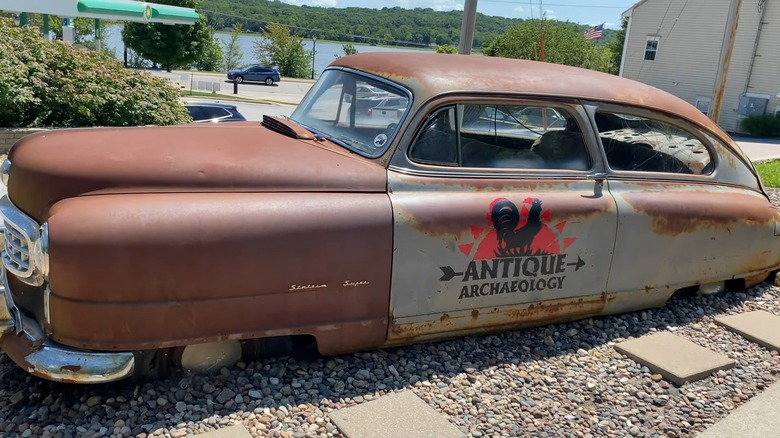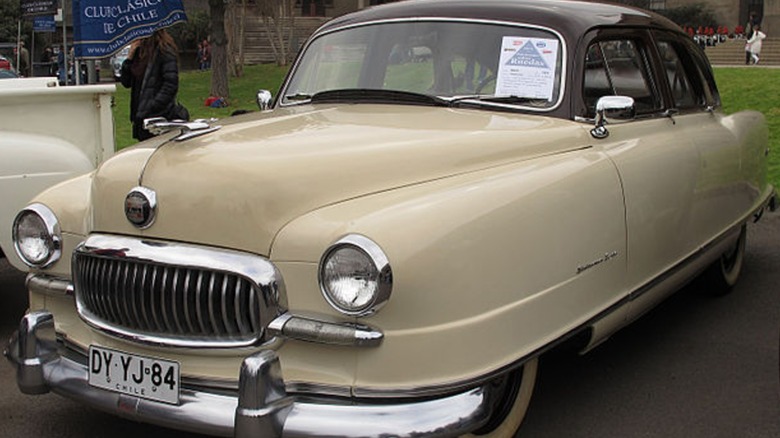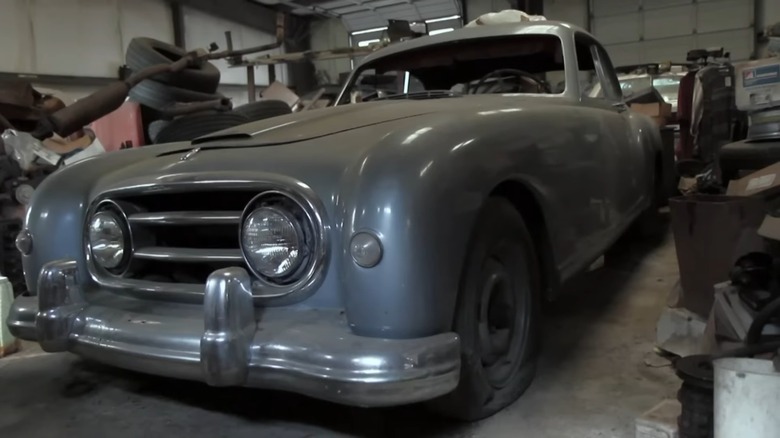What Kind Of Car Is In Front Of The American Pickers Antique Archaeology Shop?
"American Pickers" is a small-screen favorite for several reasons, chief among them its sense of adventure. Without stepping foot outside their homes, it lets viewers go on cross-country road trips, meeting average folks from all over with fascinating antiques to sell. Over the course of the show, its hosts have picked some special items, from an OG Batmobile from the 1966 TV series to a remarkable Von Dutch motorcycle. Many of these finds end up at one of co-host Mike Wolfe's two Antique Archaeology stores, and are greeted at the LeClaire, Iowa location by an awesome piece of automobile history.
Parked — or, rather, sunk into the ground — outside the LeClaire store is a rusty retro car with the Antique Archaeology logo painted on the side. As seen in the image above, this is the dilapidated husk of a Nash Statesman Super, from the first generation that spanned 1950 and 1951. This is evident by its smooth, swooping body design, its elongated and rounded windows, and the look of its grill, among details that aren't present on the second-generation models produced from 1952 to 1956.
Of all the cars that could be featured at the front of an Antique Archaeology store, this Nash Statesman is a good pick, given its history and that of the company behind it.
The story of Nash and the Statesman
The story of the Nash Motor Company dates back to 1916, when it was founded by Charles W. Nash after his purchase of the Thomas B. Jeffery Company. Fast forward to 1937, when Nash merged with the Kelvinator Corportation to form Nash-Kelvinator, but this didn't signal the end of the Nash name. From the 1940s to the 1950s, the automaker was responsible for such cars as the Nash 600, Nash Ambassador, Nash-Healey sports car — a collaboration with the Donald Healey Motor Company — and, of course, the Nash Statesman.
As noted previously, the Statesman didn't enjoy a very long tenure, with both of its generations amounting to a combined run from 1950 to 1956. Nash-Kelvinator merged with Hudson Motors in 1954 to form American Motors, beginning the gradual phasing out of the Nash brand. While certainly not among the most expensive cars of all time, Statesmen can run tens of thousands of dollars depending on the model year. After all, considering their brief production run and Nash's discontinuation nearly 70 years ago, they're by no means easy to come by. But though Nashes aren't super common today, the Antique Archaeology Statesman isn't the only Nash that's been featured on "American Pickers."
[Featured image by order_242 via Wikimedia Commons | Cropped and scaled | CC BY SA-2.0]
Other Nashes have been shown on American Pickers
Since Antique Archaeology is a principal location throughout "American Pickers," it makes sense that the first-generation Nash Statesman makes appearances in several episodes. But it's not the focal point, acting as little more than a mascot for the Antique Archaeology brand. Instead, the show's intriguing finds take center stage, including a few other astounding vehicles Nash had a hand in creating. While they don't end up buying it, in Season 20's "Georgia on My Mind," Mike Wolfe and Frank Fritz spot a near-pristine Nash-Healey at a seller's home, complete with original engine.
Another instance takes place during the ninth episode of Season 13, "A Hard Rain is Gonna Fall," where Wolfe and Fritz uncover the Nash-Healey motherlode. A seller has four of the mere 506 Nash-Healey sports cars made, and the pickers want in on the action. Though it takes some negotiating and serious number-crunching, in the end they pay a staggering $46,000 for two of the four. One is in considerably better shape than the other, which had been left to rust and decay outside for decades, but given these cars' rarity, it was worth the investment.
They may not have been around for long, but Nash, the Nash Statesman, and the other vehicles the brand was associated with remain beloved and celebrated well into the 21st century. The minds behind Antique Archaeology made a good call putting that Statesman out front to welcome their visitors.


